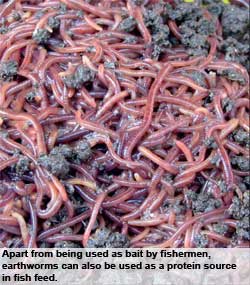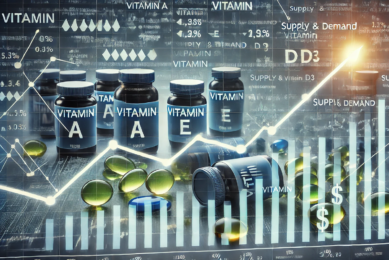Formulating fish feed using earthworms as a protein source

Formulated feeds are complete feeds which supply all the nutrients necessary for optimal growth and health of the fish in culture practices. In many areas of the world protein sources are scarce and for formulating aquafeeds earthworms as a protein source might provide an alternative to common used raw materials.
The development of species specific feed formulations support the aquaculture industry as it expands to satisfy increasing demands for affordable, safe, and high quality fish and fish products. The cost of fish feed is considered as the highest share of total cost in any aquaculture operation, therefore feed quality and feeding strategies are of great importance in fish nutrition sciences. The feed should supply all essential nutrients and energy in tune with the animal’s needs for the maintenance of vital physiological functions such as growth, reproduction and health. In aquaculture as in other animal production systems, a major issue is that of ensuring fresh and environmentally hygienic products which are related to nutrition.
Protein is usually the first nutrient considered, with the level of energy in the diet being adjusted to provide the optimum ratio. The protein has to be balanced for essential amino acids. It is the main constituent of the fish body. Animal sources are higher in protein than plant sources. Hence earthworm species Eisenia foetida are used as a source of protein to formulate the feed.
Formulation of fish feed
In an experiment fully grown earthworms of about 80 gm were collected, brought to the laboratory, washed and cleaned using blotting paper. They were sacrificed by introducing them to boiling water and squashed using mortar and pestle. Ingredients such as milk powder (60 gm), corn flour (20 gm), and eggs (70 gm) were added and mixed well. Agar powders (4 gm) were added as binding agent; turmeric, pepper and cumin powder (each of 0.5gm) and garlic paste (1 gm) were added as antibiotics. Cod liver oil (3.5 ml) and vitamin mixture of B and E (each of 1gm) were added. Ingredients in semisolid form were kept under refrigeration for 12 hrs. Then they were squeezed over a polythene sheet and dried at room temperature for 48 hrs. The dried nodules were crushed into small pellets. Pellets were sun dried to avoid fungal infection, weighted, stored in the bottles and were used as and when required.
Nutritional importance of ingredients used
Fish feed formulated from Eisenia foetida produced satisfactory growth. They are excellent source for feed formulation of cultured fish species. The dry weight analysis of Eisenia foetida shows 61% crude proteins, 9% fats, and 5% ashes
Milk powder was used for its nutritional properties as it contains all the 20 standard amino acids. It is also rich in soluble vitamins and minerals. The average amount of major nutrients in the unreconstitued milk is 36% proteins, 52% carbohydrates (particularly lactose) and 1.3% calcium. It is fortified with vitamin A and D.
Egg albumin was taken as an ingredient during feed formulation. It contains 15% protein dissolved in water. It is a rich source of about 40 different types of proteins like ovalbumin – 64%, ovatranseferin -12%, ovomucoid – 1.5% and globulin – 8%
Corn flour is used as a filler, binder and thickener in feed. It is composed of 3 gms proteins, 23 gms carbohydrates and 1gm fat. The total calories are 110 cal/gm. The major ingredients are maize and starch
Cod liver oil is derived from the liver of cod fish (Gadus callarias). It has high levels of omega-3 polyunsaturated fatty acid chain of EPA (eicosapentaenoic acid) and DHA (docosahexaenoic acid). It is a good source of fat soluble vitamins A and D. It has a fishy taste. It contains small amount of fish protein which gives a fishy smell to it. Cod liver oil along with vitamin E prevents the body from increasing oxidant stress. It reduces the tendency of blood forming clot. It helps to reduce the generation of free radicals in the body.
Vitamin B and E were used as vitamin mixture in equal proportions. Vitamin B complex is composed of thiamine mononitrite, vitamin B2, B6, B12, nicotinamide, folic acid, biotin and titanium dioxide which promotes activity of enzymes and plays an important role in cell growth and metabolism. It is an essential nutrient for growth, development and bodily functions. Vitamin E was used as a powerful antioxidant which protects the body against free radicals, which are potentially damaging byproducts of energy metabolism.
Agar powder was used as a binding agent that binds loose mixture together and forms a unique mass of the feed. It is a polymer made up of subunits of sugar galactose. Agar powder acts as an emulsifying and suspending agent.
Turmeric powder (Curcuma longa) was selected as an ingredient in feed formulation for its antibacterial, anti-inflammatory and hepatoprotective properties. It functions as an antioxidant and protects the feed from sunlight. It aids warm, mild aroma and distinctive yellow colour to the feed thus acting as feed attractants.
Modern sciences show that garlic (Allium sativum) has both the antioxidant and antibacterial properties. Hence it was introduced as an ingredient in feed formulation.
Pepper powder (Pepper nigrum) has long been recognised as a stimulant for appetite. Pepper has two main components: volatile oil and a pungent component commonly known as pipperine. Black pepper contains 0.6 to 2.6% essential oils. Nutritionally pepper contains vitamins A, B and C.
Cumin powder (Cuminum cyminum) helps in nutrient digestion and assimilation by stimulating the secretion of pancreatic enzymes.











